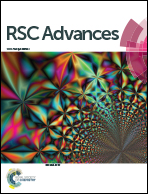SiOx-based graphite composite anode and efficient binders: practical applications in lithium-ion batteries†
Abstract
In recent years, graphite containing some proportion of SiOx-based materials for lithium-ion batteries has been investigated widely owing to its high specific capacity. An efficient binder is critical to maintain both the electronic and mechanical integrity of the SiOx-based graphite composite anode electrodes. In this study, we present a discussion on the water-soluble binders of styrene butadiene rubber (SBR) and poly acrylic acid (PAA) in a 15% SiOx–graphite composite anode with half cell (coin) and high voltage pouch battery. The peeling strength of the anode electrode using two binders was measured. The first coulombic efficiency and discharge specific capacity of SiOx–graphite was 83.6% and 626.5 mA h g−1 using the SBR as binder, while 81.2% and 636.1 mA h g−1 using the PAA binder, respectively. Based on the results from EIS, rate performance and the mechanism of the SBR emulsion binder, SBR binder is more conducive to the transfer of electrons and ions on the electrodes. In practical applications (high voltage pouch battery), the batteries with the PAA binder show better cycle performance and achieve lower swelling (7.49%) compared with those with the SBR binder (9.56%) at the 450th cycle in the range of 2.75–4.35 V.



 Please wait while we load your content...
Please wait while we load your content...